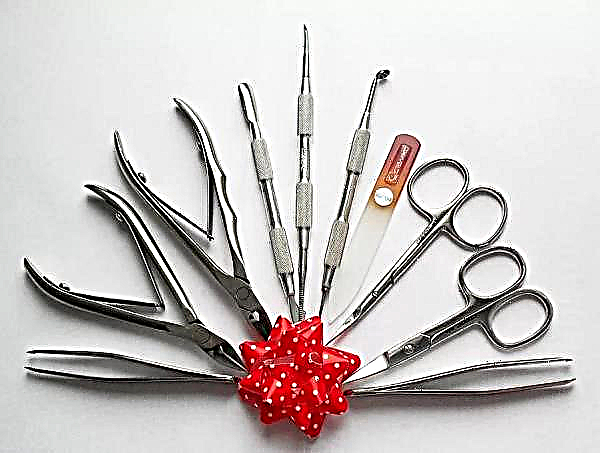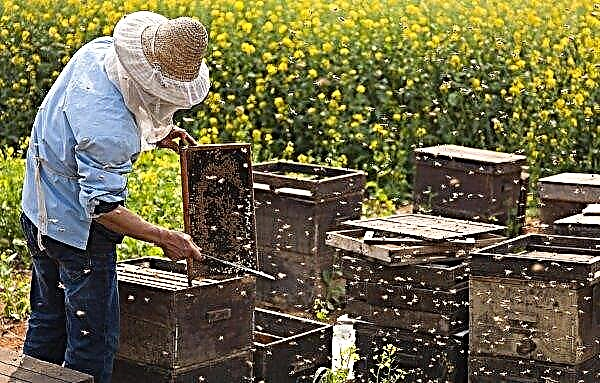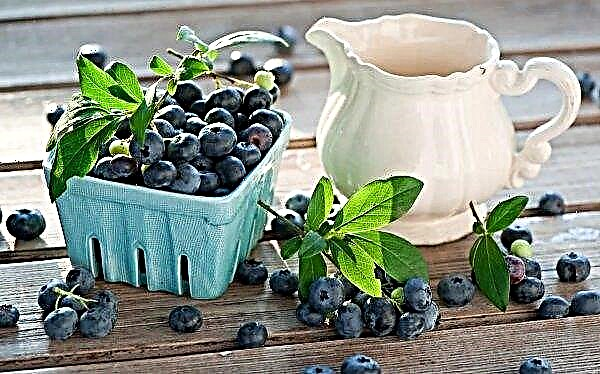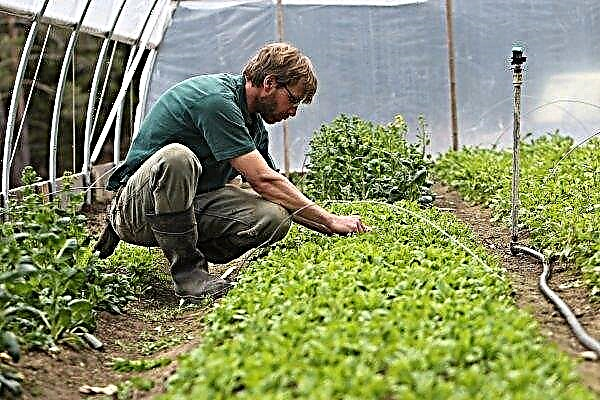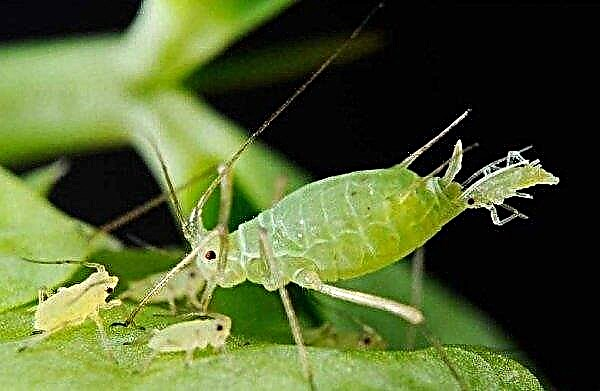Each summer resident and gardener allocates a place for carrots on his plot. This is a tasty, healthy vegetable, which is used in the preparation of a huge number of dishes as an ingredient, as a seasoning, it is added to salads and even to some desserts. But in practice it is not so easy to grow strong, large and tasty root crops. The article will help you figure out how to plant carrots properly, how to prepare the soil and how to plant the seed so that later you do not have to thin out the seedlings.
Why are carrots thinned out?
Experienced gardeners know that it is not enough to plant carrots, it must be carefully taken care of from the moment the shoots appear. The most responsible and painstaking activities in the care of seedlings are thinning and weeding. If you do not thin out the seedlings of carrots, then the crop will turn out to be weak, root crops - small and uneven, ugly. If the vegetable is planted too densely, you can lose the entire crop.
Did you know? Carrots used to grow in the wild and were bright purple, less often white and yellow.
Preparatory work
Before planting carrots, you should first select a site, prepare the soil and beds for planting seeds, and also prepare the seeds. Carrots need loose sandy or loamy soil, the sun and the absence of excess moisture - grown in a too humid environment, carrots will be deformed, root crops will not reach the expected size. The crop can be planted after potatoes, cucumbers or tomatoes.
Preparation of soil and beds
Having chosen a suitable site, you should prepare it. The first stage begins in the fall: the earth needs to be dug deep (on a full bayonet of a shovel) to saturate the soil with oxygen and add ventilated peat to it as fertilizer. Fertilizers from organic matter (for example, compost) can be applied in the spring, then you need to loosen and level the soil. Arrange the beds so that water flows freely from them.
Distance between landings
A bed for carrots is made with a height of 15–20 cm (if the earth is very wet, for example, from groundwater, it is raised even higher). The width of the beds should be 90-100 cm. You determine the length yourself, based on your needs and the size of the plot.
Important! The furrow under the seeds should not be too deep or too shallow, otherwise the seeds will either be blown away by the wind, or they will not be able to germinate through the thickness of the earth.
Furrows should not exceed a depth of 3 cm, the gap between them should be 20 cm. Note that the distance between root crops should be 2–4 cm.
Seed preparation
Before planting, carrot seeds need preparation and processing.
Each gardener chooses a convenient method for himself:
- Rejection of substandard. To do this, pour the seeds into warm water and mix. Surfaced - low-quality, they need to be decanted with water. After that, leave high-quality in water for another day, then dry them, after which you can sow.
- Heat treatment. To do this, the seeds in a gauze bag are immersed in hot water (+ 50 ° C). After that, they are immediately cooled with cold water and laid out to dry to a loose state.
- Bubbling in oxygenated water. The method allows you to get seedlings faster than the rest. The procedure is done using a bubbler, a device that resembles a compressor. The duration of the procedure is 24 hours. After the seeds are washed under running water, dried.
- Growth stimulant treatment. Not required for purchased seeds (often the manufacturer has already completed the procedure, as evidenced by the information on the package).

Methods for planting carrots without thinning
Thinning is the most painstaking and long work in caring for carrots. Gardeners try to sow carrots so as to avoid this, or thin out to a minimum. There are several ways to plant carrots so that you do not thin out the seedlings later.
Soaking and Germination
To improve seed germination, they are pre-soaked and germinated.
Soak the seed as follows:
- for 2 hours immerse in water at room temperature;
- put them in a wet towel that should be moistened periodically;
- if you wish, you can apply hardening - alternately being in heat (up to + 20 ° С) and in cold (0 ° С) for 12 hours during the week;
- after seed germination, they can be sown in open ground.

Sowing with sand
A fairly popular method of sowing, which allows you to retain additional heat and trace elements in the soil. For sowing with sand, you need to pre-treated seeds (2 tbsp. L.) Mixed with sand (0.5 buckets). Then moisten the sand with water, prepare the grooves. Pour sand in them evenly, cover with soil, pour over.
Sowing in a pouch
Originality differs in the method of sowing seeds in a bag.
For this:
- Place them in a linen bag.
- Wait until the snow melts, and, having outlined a place, place the bag in a shallow hole.
- Mix with sand (if possible, take a river).
- Plant in the open ground.
- Cover the area with film so that the seedlings do not die from frost.
- Shoots will appear in a few days.
 Using this method, you will get large, juicy fruits that will be stored for a long time. Also, this method allows you to get the crop in mid-summer.
Using this method, you will get large, juicy fruits that will be stored for a long time. Also, this method allows you to get the crop in mid-summer.Using a paste
A pasta is a great option for planting carrots. It is convenient, in addition, the paste dries much slower than water, which will create a special microclimate and give the shoots additional recharge. Shoots when using this method will appear much earlier.
Did you know? In Germany, carrots were first roasted, and then coffee was made from it, the recipe of which is still preserved in some villages.
You will need:
- water - 2 l;
- starch - 3 tbsp. l;
- watering can;
- plastic bottle (with a capacity of 2 l);
- prepared carrot seeds 2 tbsp. l
Prepare the beds in advance and water them. Then you can proceed directly to the production of paste:
Then you can proceed directly to the production of paste:
- Starch in a cup of water and pour into a pan with boiled water, stir until the lumps dissolve.
- The finished solution should collect in a drop and drop from a spoon.
- After cooling the paste, fill the bottle with it.
- Using a watering can, cover the seeds.
- Spin the bottle and mix the mass so that the seeds are evenly distributed.
Now it remains only to evenly pour the contents of the bottle into the furrows. The frequency of planting depends on the speed of irrigation. After planting, sprinkle grooves with earth.
Video: sowing carrots in a paste
Seed pelleting
The method is convenient in that the seeds increase in size, which makes planting easier. The coating material is made of filler (humus or peat), fertilizers and adhesive. The filler is sieved through a fine sieve so that the diameter of its particles does not exceed 0.3 mm. As an adhesive, starch paste, gelatin or mullein can be used.
The adhesive is diluted with water 1:10, mixed and filtered through several layers of gauze, then microfertilizers are added to it. For pelleting 100 g of seeds, 0.5-1 kg of filler and 0.3-0.5 l of adhesive solution will be needed.
The process itself looks like this:
- Place the seeds in a 3 L jar and add so much adhesive that they maintain flowability.
- Add the filler a little and shake the jar so that the seeds slide along the walls of the jar.
- Repeating these steps, you will gradually increase the shell on the surface of the seeds.
- Their diameter in the end should be 3-3.5 mm.
- After this, the shell needs to be compacted: run the seeds in a jar without adding any adhesive.
- To avoid sticking the seeds together, you can add a little sifted wood ash to the jar.
- Now you can start landing.
Video: carrot seed pelleting
On toilet paper
This method is very popular. Its advantages are space saving, the lack of constant humidity control, and you see whether the seeds have sprouted or not.
You will need:- sprayer;
- toilet paper;
- small capacity;
- dense polyethylene.
 Procedure:
Procedure:
- Cut polyethylene into strips 7-8 cm wide and convenient length.
- Place toilet paper on top of the strips.
- Well moisten the paper from the sprayer.
- Place grains of carrots on this tape, departing from the edge of 1 cm.
- Carefully roll the tape into a roll, which you put in the container so that the free edge of the tape is at the bottom.
- Add a little water to the container, cover it with a film and put in a warm place.
It remains only to wait for seedlings.
Video: carrot on toilet paper
Using duct tape
Another way to plant carrots is to use duct tape as an aid. You can buy finished tapes in the store, but they are usually expensive.
Consider the option of making such a tape yourself:
- Cook the starch paste.
- Cut toilet paper into strips 2-3 cm wide of arbitrary length.
- Lay out strips of paper, apply a paste on them.
- With a match or any convenient means at hand, place the seeds on paper at a distance of 3-4 cm.
- Dry the tapes.
- Before planting, make furrows, water them.
- Strip the seeds into the grooves with the seeds down.
- If desired, you can fill up with fertilizer on top or just sprinkle with earth.
- Pour on top, cover with a film until seedlings appear.
Video: planting carrots with tape
Homemade seeders
Accelerate and simplify the sowing process. Some gardeners make homemade devices, taking into account their needs and adjusting only for themselves, this is the advantage of homemade seeders over factory ones.
Advantages of a self-made seeder:
- sowing occurs evenly, as a result, even rows are formed;
- seeds are placed at the same depth, as a result, seedlings appear simultaneously;
- the seeder allows you to form even aisles and the distance between plants, which facilitates further care.
Important! If you decide to make a seeder with your own hands, note that the hole for the seeds must be regulated to different sizes.
The principle of assembly of all homemade seeders is reduced to the mandatory presence of:
- a reservoir for seeds;
- systems for separating seed from the total volume;
- device for powdering grooves with soil after sowing.
Parts for the seeder are selected individually, then only the assembly takes place. Many gardeners also manage to assemble a seeder from improvised means, for example from a bottle in which a hole the size of a seed is punched. But it is almost impossible to control the amount of seeds that have fallen, so be prepared for the shoots to be thicker than you expect.
Video: homemade small seed drill
Landing in tanks
For sowing, sometimes they also use a variety of objects with suitable hole sizes: salt shakers, strainers, containers from toothpicks, etc. These items also provide a rarer seed sowing in the ground, but they are very unreliable in use.
Carrot care
The main care for carrots is weed control, because the proximity to them is detrimental to this vegetable. Any weeds must be destroyed immediately after their appearance. If seedlings need to be thinned, be sure to do it. Watch the land on the bed - it must always be loose, otherwise the root crops will grow uneven, curved. Throughout the season you need to water the seedlings, then the carrots will be juicy and sweet when you remove it in the fall. Adhering to these simple tips and tricks, you can grow beautiful, sweet, large-sized carrots on the garden, which will delight you all winter.
Throughout the season you need to water the seedlings, then the carrots will be juicy and sweet when you remove it in the fall. Adhering to these simple tips and tricks, you can grow beautiful, sweet, large-sized carrots on the garden, which will delight you all winter.


